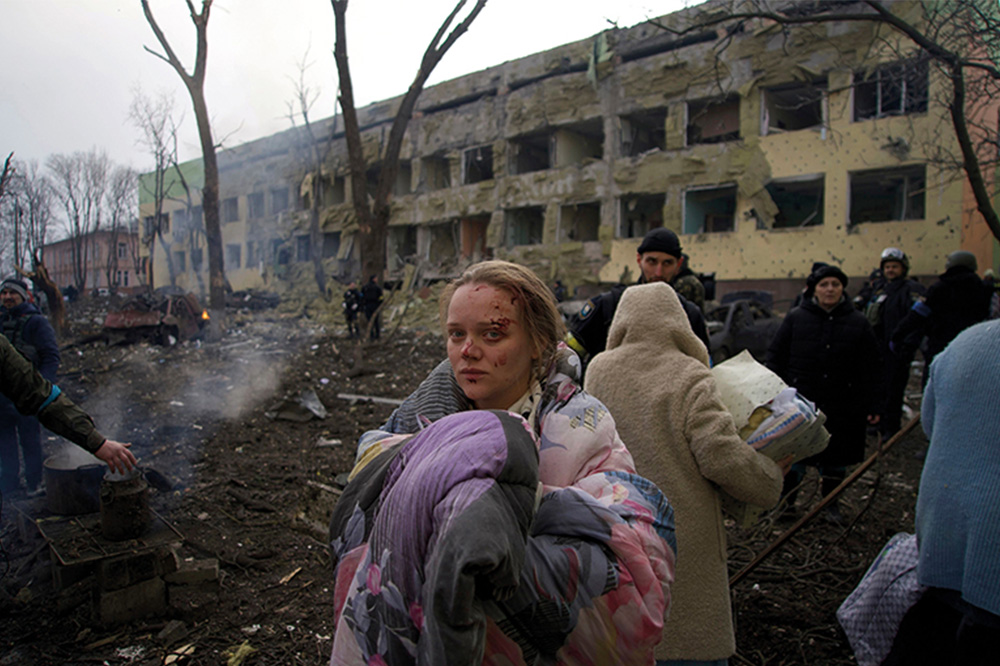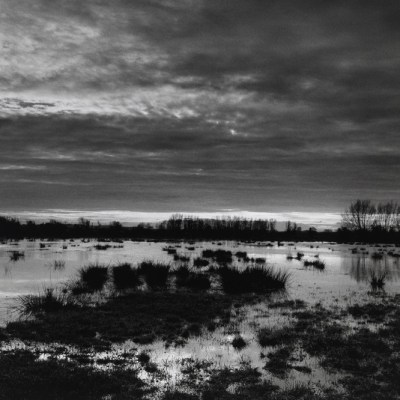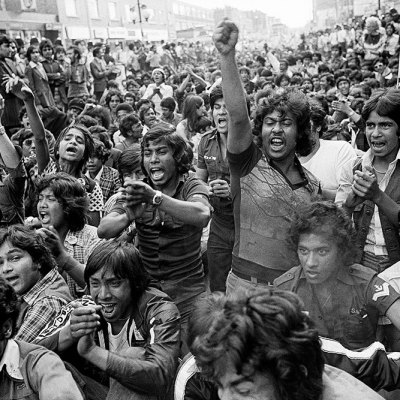From the May 2022 issue of Apollo. Preview and subscribe here.
The Russian invasion of Ukraine stands out starkly against the recent pattern of civil strife as sustained by the proxy forces of larger powers– seen in Libya, Syria, Yemen and the Democratic Republic of the Congo – conflicts which have seemed interminable, obscure and without obvious heroes (if not villains). A deep hostility to the Western media, first seen in the Iraq War, has persisted, making them very dangerous to cover. In Ukraine, by contrast, photojournalists are welcomed by a media-attuned populace who clearly understand that images are of use to them, and collaborate sympathetically with their makers. As a result, many well-known photojournalists, including Ron Haviv, Chris McGrath and Aris Messinis have travelled there, working alongside locals and photographers from the wider region.
Amid the images of armoured warfare and the devastation of cities, there are many portraits of individuals and families, often in dire circumstances. Portraits have, of course, long been an important part of war photography – we might think of Lee Miller’s photograph of 1944 of a French woman, condemned as a collaborator, whose head has been forcibly shaved, or Don McCullin’s shell-shocked Marine at the battle for Hue. Now, however, they seem to have become a more dominant mode.
Shell Shocked Marine, Vietnam, Hue (1968), Don McCullin. Courtesy Metropolitan Museum of Art, New York.

One of the most famous photojournalists currently at work is Lynsey Addario. A courageous and resourceful reporter, she is as much known for her persona as her photography (in her autobiography, It’s What I Do: A Photographer’s Life of Love and War [2015], her personal and professional life naturally took centre stage). She has developed a signature style that she carries from crisis to crisis across the globe. The renowned documentary photographer Philip Jones Griffiths wrote of what he called ‘the curse of colour’, the irruption into an image of some gaudy element that distracts the eye from the main subject, introduces an unwanted symbolic association, or just throws off the composition. The making of photographic meaning in complex and uncontrolled situations was, he thought, quite difficult enough in black and white. Since most photojournalists are now obliged to use colour, a common tactic is to subdue hues, either by selecting scenes that have little colour range, or by using backlighting, or by digitally desaturating images as they are processed. Addario, however, embraces intense and striking colour contrasts which she uses to elevate her subjects.
In a carefully composed image of separatist fighters in Darfur, she orchestrates yellows and browns, the silvery glint of gunmetal as it catches the light, and the strange hue of the sky before a sandstorm, in a remarkable graphic arrangement. If the fighters are functional elements of a combat unit, that thought is discouraged here as they are caught waiting, as if in contemplation, and depicted as distinctly individual. In such images, we have the strong sense that one exceptional individual – Addario herself – meets others who are of humble circumstances, perhaps, but nonetheless worthy of identification and celebration, who are glorified through her photographic art, especially through the use of glowing colour, as though they were illumined from within.
Fights with the Sudanese People’s Liberation Army in Darfur, Sudan. Photographed in August 2004 by Lyndsey Addario; courtesy Getty Images.

Mark Neville, a documentary photographer who has worked in Ukraine since 2015 and moved there in 2020, has also made accomplished work in this vein, in which individuals assert their distinct character – and their right to life – both as civilians and in the trenches of the long conflict over the Donbas region. His work in the project Ukraine – Stop Tanks with Books was explicitly political: to deliver the book, in which portraits predominate, to politicians, diplomats, military figures and the media so as to garner international support for Ukraine in its struggle against Russia. Only part of the print run had been sent out as the invasion struck.
Neville’s work straddles documentary and the art world. He uses large plate cameras to make highly detailed and carefully considered images of his subjects. A photograph taken in a trench in Mariupol is typical of many of the book’s portraits: the figure stands centrally in the frame and composes himself before the camera, looking into the lens. His surroundings are richly detailed in a narrow band of focus. Here, in a melancholic register, the colours of the autumn forest are traced in a gentle illumination that also falls upon camouflage, weapon and face, and if the image now seems elegiac, it is only in the light of the terrible present. As with Addario, the subject here is passive and asserts a presence through the particularity of the photograph which says, above all: this person was here, at this time, in these circumstances.
Neville has complained about foreign photographers lately flocking to Ukraine, sidelining the locals who know the situation intimately. Among the locals is Mstyslav Chernov who – along with his fellow Ukrainian photojournalist, Evgeniy Maloletka – at great personal risk, took a remarkable series of photographs of the situation in Mariupol as it was besieged and bombarded by Russian forces. Many of these are very difficult to look at, particularly the scenes in the city’s bombed maternity hospital. Portraits are only a part of this work but nonetheless an important one. Chernov photographs a young woman with a bloodied face, wrapped in her bedding, standing centre frame and looking straight at the camera. She, too, is in one sense passive, but her look is a clear and knowing address to the image’s viewers as she collaborates in making this record, and makes a claim on those who look. Despite circumstances over which he had little control, Chernov has skilfully handled the scene: the main subject is picked out from the background by a muted use of differential focus; the bare tree branches, as well as the facade of the devastated hospital, structure the photograph, while the central figure is pointed towards by the arm of a figure to the left and a pole or stick to the right. The image is part of a well-established genre in war photography, which has been seen much in the depiction of the Ukraine war: a figure standing against a ruin. Yet the woman seen here seems more than emblematic, and once again asserts her presence as a particular individual.
Solider in Mariupol, Ukraine, October 2021. Photographed by Mark Neville from Stop Tanks with Books (Nazrali Press, 2022).

Such images point to a wider condition of photojournalism, as the printed press continues to decline, and as resources devoted to serious news coverage, particularly foreign affairs, continue to shrink. As charities and NGOs supply photographers with more work, the default position has become a revamped and sometimes vapid humanism – a world of victims who, while thrust into intolerable and intractable circumstances in the unequal world order, must be accorded dignity, at least photographically. It is telling that the opening screen to Chernov’s website describes him as ‘journalist, writer, human’.
Portrait photography in conflict conditions can effectively show how civilians are a resource to be exploited and traded with politically. In Mariupol and other cities, people are killed to terrify others into submission, while the remaining population is held hostage as leverage in negotiations with Ukraine. The default view in such photography is human-rights discourse, but it is under increasing pressure as right-wing populist leaders and much of the press continually manufacture enemies, and as the rights of all are threatened not just by war but also by environmental crisis. Books do not, after all, serve to stop tanks.
From the May 2022 issue of Apollo. Preview and subscribe here.



